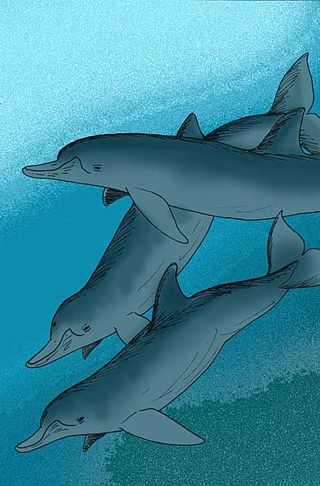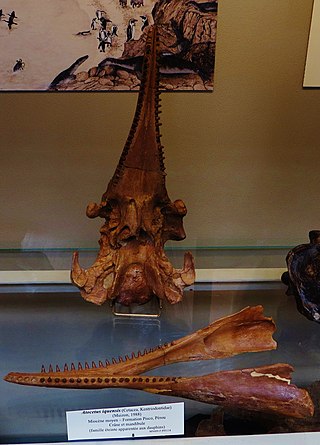
Physeteroidea is a superfamily that includes three extant species of whales: the sperm whale, in the genus Physeter, and the pygmy sperm whale and dwarf sperm whale, in the genus Kogia. In the past, these genera have sometimes been united in a single family, the Physeteridae, with the two Kogia species in the subfamily Kogiinae; however, recent practice is to allocate the genus Kogia to its own family, the Kogiidae, leaving the Physeteridae as a monotypic family, although additional fossil representatives of both families are known.

Squalodon is an extinct genus of whales of the Oligocene and Miocene epochs, belonging to the family Squalodontidae. Named by Jean-Pierre Sylvestre de Grateloup in 1840, it was originally believed to be an iguanodontid dinosaur but has since been reclassified. The name Squalodon comes from Squalus, a genus of shark. As a result, its name means "shark tooth". Its closest modern relative is the South Asian river dolphin.

Cetotherium is an extinct genus of baleen whales from the family Cetotheriidae.
Kentriodon is an extinct genus of toothed whale related to modern-day dolphins. Fossils have been found in North America, Europe and Japan. Several species have been described.

Australodelphis mirus is an extinct Pliocene dolphin. A. mirus is known from fossils found in the Sørsdal Formation, Mule Peninsula, Vestfold Hills, East Antarctica. The genus has been described as an example of convergent evolution with beaked whales.

Kentriodontidae is an extinct family of odontocete whales related to modern dolphins. The Kentriodontidae lived from the Oligocene to the Pliocene before going extinct.

Cetotheriidae is a family of baleen whales. The family is known to have existed from the Late Oligocene to the Early Pleistocene before going extinct. Although some phylogenetic studies conducted by Fordyce & Marx 2013 recovered the living pygmy right whale as a member of Cetotheriidae, making the pygmy right whale the only living cetotheriid, other authors either dispute this placement or recover Neobalaenidae as a sister group to Cetotheriidae.

Orcinus citoniensis is an extinct species of orca identified in the Late Pliocene of Italy and the Early Pleistocene of England. It was smaller than the modern killer whale, 4 m (13 ft) versus 7 to 10 m, and had around 8 more teeth in its jaw. It may have resembled the modern killer whale in appearance, and could represent a transitional species between the modern killer whale and other dolphins. O. citoniensis could have hunted fish and squid in pods, and coexisted with other large predators of the time such as the orcinine Hemisyntrachelus and the extinct shark Otodus megalodon.

Scaldicetus is an extinct genus of highly predatory macroraptorial sperm whale. Although widely used for a number of extinct physeterids with primitive dental morphology consisting of enameled teeth, Scaldicetus as generally recognized appears to be a wastebasket taxon filled with more-or-less unrelated primitive sperm whales.

Eschrichtioides is an extinct genus of baleen whale known from the early Pliocene of Northern Italy. Its type species, E. gastaldii, had a complex taxonomic history, starting as a cetothere, then as an extinct member of Balaenoptera, before being finally recognized as a relative of the gray whale.

The Pisco Formation is a geologic formation located in Peru, on the southern coastal desert of Ica and Arequipa. The approximately 640 metres (2,100 ft) thick formation was deposited in the Pisco Basin, spanning an age from the Late Miocene up to the Early Pliocene, roughly from 9.6 to 4.5 Ma. The tuffaceous sandstones, diatomaceous siltstones, conglomerates and dolomites were deposited in a lagoonal to near-shore environment, in bays similar to other Pacific South American formations as the Bahía Inglesa and Coquimbo Formations of Chile.

Atocetus is an extinct genus of pontoporiid dolphin found in Miocene-age marine deposits in Peru and California.

Albicetus is a genus of stem-sperm whales that lived during the Miocene Epoch, around 15 million years ago, and was discovered in Santa Barbara, California in 1909. It was categorized for decades as belonging to a group of extinct walruses erroneously thought to be sperm whales. It was named Albicetus, meaning "white whale", is a reference to the leviathan in Herman Melville's classic 1851 novel Moby-Dick.
Macrokentriodon is an extinct genus of giant dolphin once assigned to the paraphyletic/polyphyletic family Kentriodontidae. Remains have been found in the late Miocene (Serravallian) Choptank Formation of United States.

Lophocetus is an extinct genus of dolphin belonging to the clade Delphinida that is known from late Miocene (Tortonian) marine deposits in California and Maryland. Although usually placed in Kentriodontidae, recent studies have found it only distantly related to Kentriodon.
Hadrodelphis is an extinct genus of dolphin once assigned to the paraphyletic/polyphyletic family Kentriodontidae. Remains have been found in the middle Miocene (Langhian) Calvert Formation of United States.
Eudelphis is an extinct genus of sperm whale belonging to Physeteroidea that lived in the ancient North Sea basin about 16-11 million years ago, during the middle Miocene (Langhian).

Macroraptorial sperm whales were highly predatory whales of the sperm whale superfamily (Physeteroidea) of the Miocene epoch that hunted large marine mammals, including other whales, using their large teeth. They consist of five genera: Acrophyseter, Albicetus, Brygmophyseter, Livyatan and Zygophyseter. All species are known by at least a skull, and are informally grouped without a family designation. They were all likely the apex predator of their habitats, comparable to the modern day killer whale, and achieved great lengths, with one species—Livyatan—measuring about 13.5–17.5 m (44–57 ft).
Hoplocetus is an extinct genus of raptorial cetacean of the sperm whale superfamily, Physeteroidea. Its remains have been found in the Miocene of Belgium, France, Germany and Malta, the Pliocene of Belgium and France, and the Pleistocene of the United Kingdom and South Carolina.












